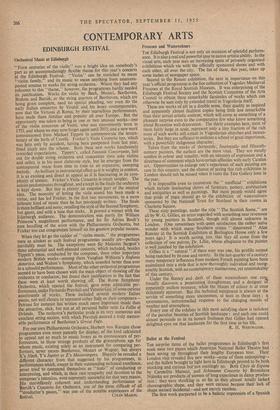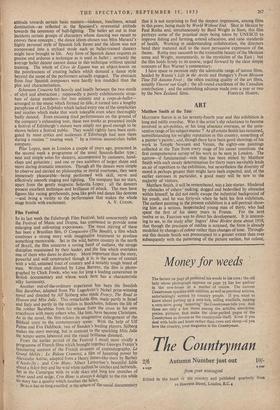Ballet at the Festival
THE surprise items of the ballet programmes in Edinburgh's first week were two pieces which American National Ballet Theatre had been saving up throughout their lengthy European tour. Their London visit revealed five new works—some of them uninspiring— and the ballets brought to light here in Edinburgh proved to be both shocking and curious but not excitingly so. Both Cirro de Espana by Carmelita Maracci, and Schumann Concerto by Bronislava Nijinska are products of women of long experience in dance produc- tion ; they were shocking in as far as they almost totally lacked choreographic shape, and they were curious because their lack of shape seemed incidental—and not merely careless.
The first work purported to be a balletic impression of a Spanish
attitude towards certain basic matters—violence, loneliness, sexual domination—as reflected in the Spaniard's reverential attitude towards the ceremony of bull-fighting. The ballet set out in four incidents certain groups of characters whose dancing was meant to convey these concepts ; the dance idiom chosen was Miss Maracci's highly personal style of Spanish folk forms and the idiom was not compressed into a stylised mode such as ballet-trained dancers might have brought to life. Any form of Spanish dance requires as precise and arduous a technique as is used in ballet ; certainly the average 'ballet dancer cannot dance in this technique without special training. The whole of Circo de Espana was an object-lesson on the pointlessness of creating ballets which demand a dance style beyond the scope of the performers actually engaged. The abstracts from four Spanish composers were hardly less muddled than the plot and characterisation. Schumann Concerto fell heavily and loudly between the two stools of idyll and abstraction ; supposedly a purely exhibitionistic struc- ture of dance numbers—for two soloists and a corps-de-ballet- arranged to the music which formed its title, it turned into a lengthy paraphrase of Les Sylphides which lacked every one of the simplicities and niceties which make that work tolerable even when thoroughly badly danced. Even excusing tired performances on the ground of the company's exhausting tour, these two works as presented inside a festival of Edinburgh's stature were simply not good enough to be shown before a festival public. They would rightly have been casti- gated by most critics and audiences if Edinburgh had seen them during a routine " touring week " by a routine second-class ballet company.
Pilar Lopez, seen in London a couple of years ago, presented in the second week a programme of the usual Spanish-Ballet type ; neat and simple solos for dancers, accompanied by castanets, hand- claps and guitarists ; and one or two numbers of larger shape and more daring dramatic intention. Though all the dances were simple to observe and carried no philosophic or moral overtones, they were immensely pleasurable—being performed with skill, verve and effectively smooth staging and lighting. The company has no stars, apart from the gently magnetic Seilorita Lopez ; all the dancers possess excellent technique and brilliance of attack. The men have figures like racing greyhounds, pose like gods and dance like demons —and bring a virility to the performance that makes the whole



































 Previous page
Previous page